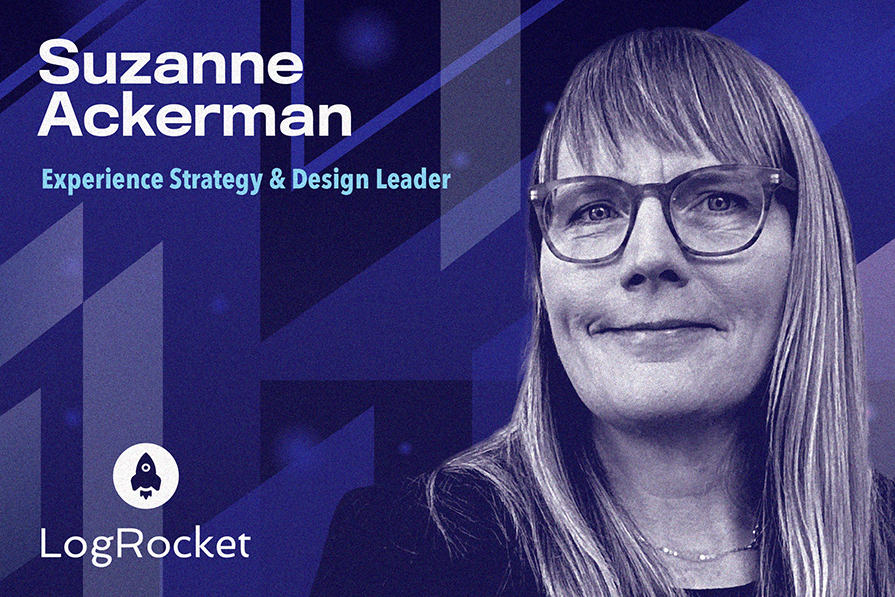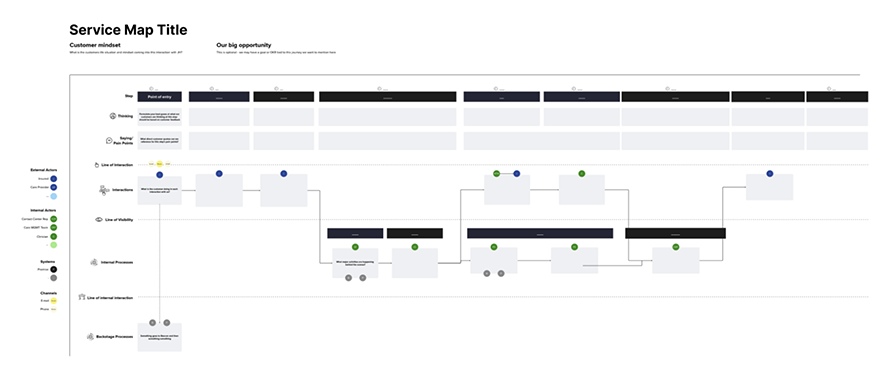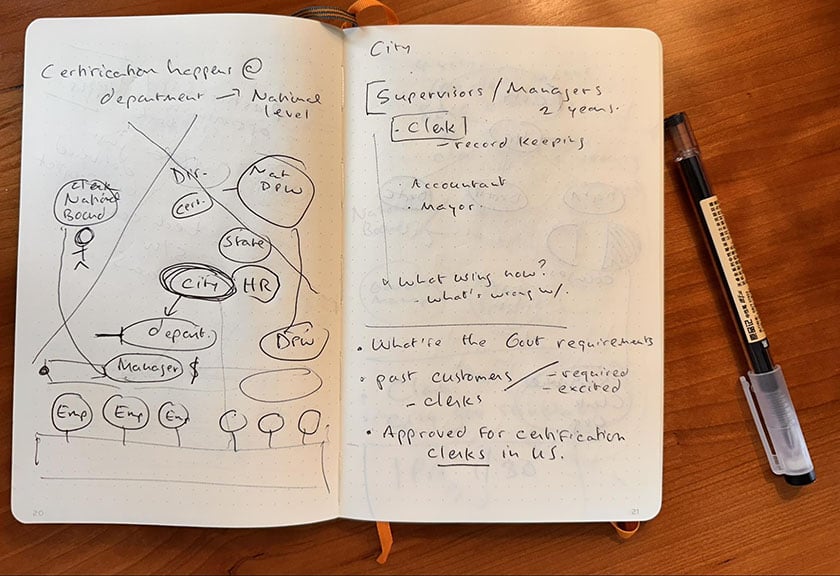Suzanne Ackerman is a people-focused, results-driven, strategic design leader who most recently served as Director, Experience Strategy and Design at John Hancock. She began her career in production and project management in events, film and digital. Suzanne’s transition to design came at Digitas North America, where she moved from delivery management into user experience, advancing to a Senior Designer. Prior to joining John Hancock, Suzanne held leadership roles at IBM, Tank Design, and PJA Advertising + Marketing.

In our conversation, Suzanne talks about how she leverages visual mapping to align teams and break down complex projects. She discusses the difference between service mapping and customer journey mapping, as well as the important role that curiosity plays in design.
Overall, I believe they’re complementary. Customer journey and service mapping are both visual representations of a process over time, but they each have a slightly different focus.
A customer journey map takes the perspective of the customer — it’s about their mindset, their experience, and what they’re feeling, thinking, and needing at each step. Usually we’re designing for a business need, but ultimately, the customer needs to be at the center. A customer journey map will include moments outside of the interactions for the actual business problem we’re trying to solve, which gives us the full picture of the person.
For example, if you’re mapping the journey for someone looking for a new dentist, you would focus on the emotions and knowledge they bring into the process. People feel nervous when they’re looking for a new dentist — they’re worried about pain and maybe embarrassed about their teeth. They have feelings that you want to account for, and that will influence how a dental business, crafts its messaging, positioning, and brand.
A service map, on the other hand, focuses on the whole system that supports the customer experience when that customer interacts with a business. It’s not just about their feelings, but the processes and tools behind the scenes. In the dental office example, the service map might include the scheduling system used by the receptionist, how reminders are sent out to patients, how medical records are transferred securely in the backend, how insurance benefits are verified, and more.
You can think of the journey map as the emotional human-centered layer and then the service map as the operational technical layer that supports that emotional journey. Together, they create a comprehensive picture of what the customer wants and how the business can deliver it.

Sure. One example is from a national supermarket chain. This was back when people in this industry were still trying to figure out how to deliver digital couponing. It was a huge transformation to go from paper couponing to digital.
Customers were used to clipping paper coupons and different types of customers viewed the process differently. For some, it was a task they wouldn’t bother with. Others would clip a coupon that was recently relevant, or they would put the effort in if it was a good enough discount. Then, for some shoppers, clipping coupons was a ritual that they did every week — it was part of their financial planning.
When transitioning to digital couponing, journey mapping helped us understand the different mindsets and attitudes that people had about coupons. With digital couponing, some people were going to actually lose a loved routine, while others were going to be enabled with an easier way to save money.
There were also technical differences between people. How comfortable would they be switching to a new system? On the service mapping side, how would customers discover and redeem their coupons? Would they need to print them? Would they need to use their phones? What systems and tools would the customer need to get the coupons? What systems and tools would the staff need to process them at checkout? Further down the funnel, what kind of systems and tools would the manufacturer, who issued the coupon, need to get that redemption in and for the store to communicate that?
Ultimately, the target became turning digital coupons into loyalty cards. That interim step seemed obvious but presented a lot of problems. Customers sometimes forget them at home, miss a printout, etc. The whole shift created technical challenges — even with moving to digital loyalty cards. This transformation took a lot to complete, but it was worth it. Customers still love the convenience. We brought in all those customers who thought that couponing was not something they would spend their time on because now, it no longer took any time to do. We also gained new data insights.
The biggest challenge is establishing comfort in a new process. Service mapping is such a holistic way of tackling projects and initiatives that the value becomes clear very quickly. But getting people to show up to that first workshop is the biggest hurdle. Once that starts happening, however, the challenge becomes everyone getting aligned on the problem. Each function will come to the table with a different problem in their head.
For example, the engineering team might focus on system migrations or technical constraints while the operations team might be thinking about the prioritization of call center workflows. Business leaders might look at different sales targets or cost efficiencies. Co-design, as a process, helps bring these priorities together.
As a service or customer experience designer, you start with a broad swath of people and have a framework to start the conversation. With that broad swath, you’re going to have to make some assumptions, but those individual conversations can help bring people together faster. Let’s say you have six people with a goal to get them to all do a co-design exercise. Having individual conversations with each of them in advance to better understand and recognize where their problems are, as well as doing a bit of prep work, goes a long way.
Making sure stakeholder input is a priority has to start at the beginning. You have to come in by understanding what’s important to the focus of each stakeholder. Every organization wants to make things better for its customers, but every organization also has important business priorities. Make stakeholder input one of the first parts of any given initiative. That’s why in each discovery process, I lead with stakeholder interviews.
You can use that initial input and tools to do a first draft of the service map. Then, you can figure out where the different stakeholder needs and priorities can be highlighted. That synthesized version — where everybody’s voice is baked in — helps you get buy-in from the beginning. Stakeholders see their voices reflected in the map, and that starts building alignment and trust. It’s important to make sure that you’re not losing any given person’s voice all along the way. Storytelling is key.
In nearly every situation, I have a pen in my hand. I’m a very visual person, so I find it helpful to draw the conversation. To me, everything can be translated into a map. There are very few things that happen in life that aren’t complicated when you dig into the details. Visual tools give us a way to look at the same thing outside of verbal language.
A service or journey map helps make sense of the complexity and get people talking about the same thing. There are different kinds of maps too. That ecosystem map gives a high-level view of all the players, which would be impossible to represent in a linear service map.
For example, here’s a quick notebook sketch from a recent intake meeting with a client. It captures the startup’s target ecosystem as we discussed it. This simple, in-the-moment tool helped us get to a shared understanding through a visual as we talked:

When you get into a service mapping exercise, you need to gain some focus to have the story make sense around a few key transactions, and then you can have many service maps that illustrate different players’ points of view.
I also like priority maps. This is a common tool used in product management. There are so many different opportunities lining up. If you take that whole set of blocks and detach them from the service map so that you’re simplifying your view, you can bring those into a prioritization map, which can be as simple as a feasibility versus impact matrix. Then, everything rolls up into the product roadmap. That becomes the how and the when of getting everything done.
In the supermarket example, a lot of people have a good sense of the holistic picture, but everybody’s bringing a different perspective. There’s the shopper, the shopper’s family, the checkout staff, and the person who works for the brand that’s giving a discount. You also have the person who is processing coupons in the background, as well as the head of couponing at the manufacturer who’s making decisions. So many different people play into a system, and mapping helps make sense of the complexity.
I studied comparative literature, but I was drawn to design because it is one of the more holistic perspectives on problem-solving. There’s the visual side of design, which is quite different from information design. It’s all connected, but I was specifically drawn to the UX and design thinking field because I’m so passionate about problem-solving. I love looking at the big picture.
Design provides a unique perspective. I often say that designers are, in some ways, a bit like therapists. We are really good listeners, we understand everybody’s problems, and we figure out how to listen and co-solve problems. My love of solving problems and ability to see everything holistically made this field a really easy and wonderful fit for me.
I put them into two categories: relationships and trust, and curiosity and openness. I focus on the relationship between customers and the business, as well as my peers and stakeholders. Learning from each other’s expertise is also part of relationships. Everyone should feel included in the process, and there should be a sense of shared ownership. That’s one of the key needs in getting anything done and getting it done well — everyone needs to feel that they were successful at the end of the day, not that they were enabling somebody else’s success.
This concept bleeds into how I lead teams as well. I aim to celebrate everyone’s unique strengths and perspectives, but also make sure that the team is running as a unit where everybody is excited about each other’s success as well.
As for curiosity, this is why I fell into this field. I love learning about new things and I love how much I don’t know. That relates back to listening to stakeholders and peers, and recognizing how much I have to learn from experts in the room. I find that to be an important quality in leadership.
If an interviewee has no questions I feel like that’s a quick indicator that there’s not a whole lot of curiosity present. It feels impossible that I’ve described everything in a 30-minute chat that a candidate needs to know. Also, I want to see them shift their mindset from one framework to another. The ability to make analogies shows the ability to think about how different systems can be similar.
You’re unlikely to have expertise in every single industry that you work with. As a designer, I’ve worked with everything from insurance companies to supermarkets to coffee shops to municipalities. I don’t know everything about all of these verticals, but I’m curious. A display of curiosity is the ability to understand that there are repeatable patterns and things that you can bring from one industry to another. This helps me figure out if someone is a creative thinker, and that’s a very important skill I hire for.

LogRocket identifies friction points in the user experience so you can make informed decisions about product and design changes that must happen to hit your goals.
With LogRocket, you can understand the scope of the issues affecting your product and prioritize the changes that need to be made. LogRocket simplifies workflows by allowing Engineering, Product, UX, and Design teams to work from the same data as you, eliminating any confusion about what needs to be done.
Get your teams on the same page — try LogRocket today.

A practical framework for PMs to use AI in ideation without sacrificing judgment, strategy, or decision quality.

A practical five minute revenue estimation method to help product managers compare ideas, drop low impact features, and prioritize smarter.

A practical guide for PMs who want to stop being bottlenecks, delegate smarter, and lead teams effectively with a clear ownership framework.

Stop letting unreliable data block features. Treat data as inventory to track quality, ownership, and ship with confidence.